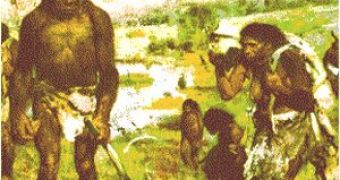Since the first Neanderthal finding in 1856 in the Neander Valley, western Germany, the remains of about 400 individuals have been found, at sites ranging from southern England and Portugal to the Middle East and Turkmenistan.
Fossil data indicated that from a foothold north of the Mediterranean, Homo heidelbergensis populations evolved into the Neanderthals in Europe, while African populations followed a different evolutionary pathway that led to Homo sapiens.
Fossil remains as old as 400,000 years depict Neanderthals as a reasonably sophisticated species that crafted tools and weapons and buried its dead, but lacked something in the competition with modern humans, which led to their extinction some 30,000 years ago.
Using different approaches, two teams of geneticists have started to study Neanderthal genome, comparing it at the same time with modern humans and chimps.
Starting from genetic fragments recovered from Neanderthal ancient bones, scientists believe that the effort of reconstructing 3 billion bases of the whole Neanderthal genome will take two years, task seen as impossible by many not so long ago.
Scientific community agrees that these "are the most significant contributions in this field since the discovery of Neanderthals 150 years ago."
One international team led by Dr Svante Paabo, Director of the Genetics Department at the Max Planck Institute for Evolutionary Anthropology in Leipzig, using pyrosequencing, have till now sequenced one million base pairs of Neanderthal DNA, removing impurities and matching the DNA fragments against the template of human DNA.
This team uses strands of DNA from a leg bone found in a cave in Vindija, Croatia, and an upper arm bone from the Neander valley in Germany.
Microbes' contamination means that only 5 % of the DNA found in bones belongs to Neanderthals, so the team has a huge and time costing sorting task.
"Our finding that the Neanderthal and human genomes are at least 99.5 % identical led us to develop and successfully implement a targeted method for recovering specific ancient DNA sequences," said Paabo.
Humans and chimps share 99 % of their genome.
As the difference between modern humans and Neanderthals is much smaller, sequencing Neanderthal DNA would pinpoint the genes that make us humans like complex brains and the capacity of developing sophisticated language.
This investigation resulted in the estimation that Neanderthal DNA diverged between 465,000 and 569,000 years ago, and, like humans, they "derived from a very small ancestral population of about 3,000 individuals."
And, although they cohabited for some millennia in Europe, humans and Neanderthals don't seem to have mixed.
Another team, an American one, used "metagenomic" technique to multiply some 65,000 base pairs of Neanderthal DNA through replication in bacteria and enzymes.
"If we're really interested in what makes us truly modern humans, we need to look at the genetic changes that have happened in the past 200,000 to 300,000 years, and to identify those changes we need to look at our closest relative, the Neanderthal." said Paabo.
The American team estimated a split off in evolutionary paths between 120,000 and 670,000 years ago. The complete Neanderthal genome would clarify another debate.
"In evolution, how important are mutations in genes that result in structural and physiological changes, compared with mutations that affect the regulation of those genes?"
"The Neanderthal genome will tell us much more about human biology than sequencing any other individual around," said Michael Egholm.
"The ultimate goal is to understand humans, with the real pot of gold for humanity being the genes associated with cognition. We want to know, what are the handful of genetic changes that separated modern humans from the Neanderthal?"
And why not, to satisfy our curiosity about our extinct cousins: if they had an articulate form of language, how their brain was constructed, if they had light or dark skins, and the size of the Neanderthal population.

 14 DAY TRIAL //
14 DAY TRIAL //